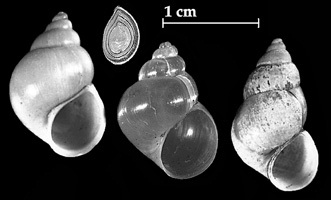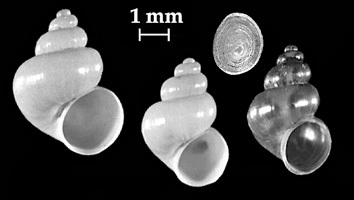The only genus in this family in north-west Europe is Bithynia. The shell is conical in general shape, with a rounded base, convex whorls and an oval or pear-shaped aperture. The operculum is calcareous and bears concentric rings. It is not retractable beyond the aperture.

Bithynia tentaculata
(Linnaeus, 1758)
Genus: BITHYNIA Leach, 1818
Two fairly similar species occur in Britain.
Bithynia tentaculata (Linnaeus, 1758)
Description: The shell is glossy and semi-transparent, with 5 – 6 moderately rounded whorls separated by a shallow suture. The apex is pointed, and the umbilicus is almost completely closed. Mouth aperture and operculum are pear-shaped.
Size: Height: 10 – 17 mm. Breadth: 6 – 8 mm.
Habitat: It is found in streams, rivers, canals, ponds and lakes, throughout the British Isles as far north as Moray.

Bithynia leachii
(Sheppard, 1823)
Bithynia leachii (Sheppard, 1823)
This species has a thinner shell than Bithynia tentaculata, and 4 – 5 tumid whorls separated by a deep suture. The short spire has a pointed apex. The umbilicus is open, although small. The mouth aperture and operculum are almost circular, not pear-shaped as in the case of B. tentaculata.
Size: Height: 6 – 6.5 mm. Breadth: 4 – 4.5 mm.
Habitat: It occurs in slowly flowing waters and in the British Isles it tends to have a slightly more south-easterly distribution than B. tentaculata, although it has been recorded as far north as Edinburgh.
